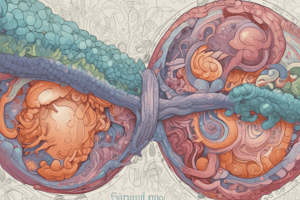Podcast
Questions and Answers
What is the common pathogenetic mechanism in autoimmune diseases?
What is the common pathogenetic mechanism in autoimmune diseases?
- Genetic mutation
- Breakdown of immune tolerance (correct)
- Overactive immune response
- Epigenetic changes
Sjogren syndrome is mainly characterized by damage to the salivary and lacrimal glands.
Sjogren syndrome is mainly characterized by damage to the salivary and lacrimal glands.
True (A)
In systemic lupus erythematosus, ____ disease affects approximately 40-70% of patients and is considered a major cause of morbidity and mortality.
In systemic lupus erythematosus, ____ disease affects approximately 40-70% of patients and is considered a major cause of morbidity and mortality.
renal
Match the autoimmune disease with its characteristic manifestation:
Match the autoimmune disease with its characteristic manifestation:
What role do antianxiety techniques and pain control play in preventing medical emergencies during dental procedures?
What role do antianxiety techniques and pain control play in preventing medical emergencies during dental procedures?
Which autoimmune diseases may result in hyposalivation and xerostomia?
Which autoimmune diseases may result in hyposalivation and xerostomia?
Periodontal disease is more prevalent in patients with autoimmune diseases.
Periodontal disease is more prevalent in patients with autoimmune diseases.
What can result from myelotoxic drugs, such as atrophy, neutropenic ulcers, and petechiae?
What can result from myelotoxic drugs, such as atrophy, neutropenic ulcers, and petechiae?
Flashcards are hidden until you start studying
Study Notes
Autoimmune Diseases
- Represent a diverse family of conditions characterized by an immune-mediated response against self
- Over 100 distinct autoimmune diseases have been described
- Common pathogenetic mechanism: breakdown of immune tolerance, leading to autoreactive T lymphocytes and/or autoantibodies triggering autoimmunity
Sjögren Syndrome
- Autoimmune disorder that damages exocrine glands, including salivary and lacrimal glands
- Characterized by dry mouth and dry eyes, with lymphoid infiltrates and serum autoantibodies
- Two clinical forms:
- Primary Sjögren syndrome (SS-1): dry eyes and dry mouth, without connective tissue disease
- Secondary Sjögren syndrome (SS-2): dry eyes and dry mouth, with other autoimmune diseases, such as rheumatoid arthritis (RA), systemic lupus erythematosus (SLE), or mixed connective tissue disease
Systemic Lupus Erythematosus (SLE)
- Autoimmune disease with unpredictable relapsing-remitting course
- Presents with variable clinical features, including:
- Mild joint and skin disease
- Multiorgan life-threatening renal, hematologic, and CNS involvement
- Etiology and pathogenesis: genetic predisposition, environmental, and hormonal factors
- Epidemiology:
- Females are affected 1.2-15 times more than males
- Peak ages of prevalence: 45-69 for females, 40-89 for males
- Clinical features:
- Nonspecific signs and symptoms: fatigue, headache, arthralgias, lymph node enlargement, fever, weight loss
- Renal disease: affects approximately 40-70% of patients, major cause of morbidity and mortality
- Musculoskeletal system: arthritis, arthralgias, myalgias
- Cardiovascular manifestations: vasculitis, pericardial effusions
- Nervous system: anxiety, mood disorders, psychosis, seizures, headaches, myelin
- Pulmonary, gastrointestinal, and ocular manifestations
- Mucocutaneous manifestations:
- Facial eruption (butterfly rash)
- Discoid lesions, photosensitivity
- Oral manifestations:
- Nonspecific ulcerations, erythematous or discoid lesions on palatal mucosa, buccal mucosa, and gingiva
- Lupus cheilitis (vermilion border of the lower lip)
Systemic Sclerosis (Scleroderma)
- Umbrella term for diverse group of disorders with excessive cutaneous fibrosis
- Subclassified into:
- Localized scleroderma (LSc): limited to skin involvement
- Systemic sclerosis (SSc): affects multiple organs in addition to skin
- Epidemiology:
- Women are more commonly involved than men
- Racial predisposition for Caucasian populations
- Pathogenesis:
- Interplay between early immunologic events and vascular changes, resulting in activated fibroblasts
- Clinical features:
- Raynaud's phenomenon
- Musculoskeletal involvement: arthralgias, morning stiffness
- Gastrointestinal manifestations: dysmotility, gastroesophageal reflux
- Pulmonary complications
- Cutaneous manifestations:
- Skin thickening, puffy appearance of extremities, prone to ulceration and deformities
- Telangiectasias
- Oral manifestations:
- Rigid lips, microstomia, difficulty in speech and swallowing
- Tongue hardening, telangiectasias
- Temporomandibular disorders, mandibular resorption, periodontal disease, xerostomia, susceptibility to local infections
Dental Management of Patients with Immune-Mediated Diseases
- Susceptibility to infections:
- Odontogenic infections, infectious endocarditis, CNS infections, distal skeletal infections
- Leukopenia, herpes zoster, HPV infection, oral candidiasis
- Risk of bleeding:
- Coagulation impairment due to thrombocytopenia, myelotoxic drugs, anticoagulants, or antiplatelet regimens
- Adrenal suppression:
- Corticosteroids, risk of adrenal suppression during dental procedures
- Cardiovascular disease:
- Assess general condition, communicate with physician, antianxiety techniques, pain control
- Hyposalivation and xerostomia:
- Salivary gland involvement, fibrotic changes, medications causing hyposalivation
- Dental and periodontal disease:
- Periodontal disease prevalence, customized toothbrushes, oral mucosal involvement as adverse effect of medications
Studying That Suits You
Use AI to generate personalized quizzes and flashcards to suit your learning preferences.




